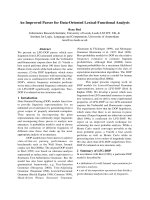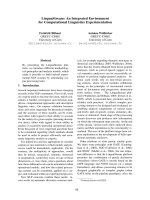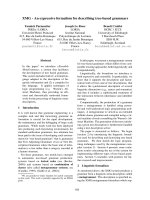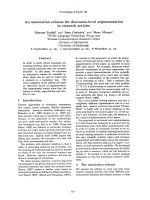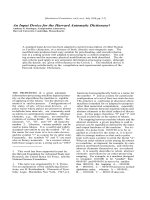Báo cáo khoa học: "An Automatic Method for Summary Evaluation Using Multiple Evaluation Results by a Manual Method" pptx
Bạn đang xem bản rút gọn của tài liệu. Xem và tải ngay bản đầy đủ của tài liệu tại đây (217.86 KB, 8 trang )
Proceedings of the COLING/ACL 2006 Main Conference Poster Sessions, pages 603–610,
Sydney, July 2006.
c
2006 Association for Computational Linguistics
An Automatic Method for Summary Evaluation
Using Multiple Evaluation Results by a Manual Method
Hidetsugu Nanba
Faculty of Information Sciences,
Hiroshima City University
3-4-1 Ozuka, Hiroshima, 731-3194 Japan
Manabu Okumura
Precision and Intelligence Laboratory,
Tokyo Institute of Technology
4259 Nagatsuta, Yokohama, 226-8503 Japan
Abstract
To solve a problem of how to evaluate
computer-produced summaries, a number
of automatic and manual methods have
been proposed. Manual methods evaluate
summaries correctly, because humans
evaluate them, but are costly. On the
other hand, automatic methods, which
use evaluation tools or programs, are low
cost, although these methods cannot
evaluate summaries as accurately as
manual methods. In this paper, we
investigate an automatic evaluation
method that can reduce the errors of
traditional automatic methods by using
several evaluation results obtained
manually. We conducted some
experiments using the data of the Text
Summarization Challenge 2 (TSC-2). A
comparison with conventional automatic
methods shows that our method
outperforms other methods usually used.
1 Introduction
Recently, the evaluation of computer-produced
summaries has become recognized as one of the
problem areas that must be addressed in the field
of automatic summarization. To solve this
problem, a number of automatic (Donaway et al.,
2000, Hirao et al., 2005, Lin et al., 2003, Lin,
2004, Hori et al., 2003) and manual methods
(Nenkova et al., 2004, Teufel et al., 2004) have
been proposed. Manual methods evaluate
summaries correctly, because humans evaluate
them, but are costly. On the other hand,
automatic methods, which use evaluation tools or
programs, are low cost, although these methods
cannot evaluate summaries as accurately as
manual methods. In this paper, we investigate an
automatic method that can reduce the errors of
traditional automatic methods by using several
evaluation results obtained manually. Unlike
other automatic methods, our method estimates
manual evaluation scores. Therefore, our method
makes it possible to compare a new system with
other systems that have been evaluated manually.
There are two research studies related to our
work (Kazawa et al., 2003, Yasuda et al., 2003).
Kazawa et al. (2003) proposed an automatic
evaluation method using multiple evaluation
results from a manual method. In the field of
machine translation, Yasuda et al. (2003)
proposed an automatic method that gives an
evaluation result of a translation system as a
score for the Test of English for International
Communication (TOEIC). Although the
effectiveness of both methods was confirmed
experimentally, further discussion of four points,
which we describe in Section 3, is necessary for
a more accurate summary evaluation. In this
paper, we address three of these points based on
Kazawa’s and Yasuda’s methods. We also
investigate whether these methods can
outperform other automatic methods.
The remainder of this paper is organized as
follows. Section 2 describes related work.
Section 3 describes our method. To investigate
the effectiveness of our method, we conducted
some examinations and Section 4 reports on
these. We present some conclusions in Section 5.
2 Related Work
Generally, similar summaries are considered to
obtain similar evaluation results. If there is a set
of summaries (pooled summaries) produced from
a document (or multiple documents) and if these
are evaluated manually, then we can estimate a
manual evaluation score for any summary to be
evaluated with the evaluation results for those
pooled summaries. Based on this idea, Kazawa et
603
al. (2003) proposed an automatic method using
multiple evaluation results from a manual
method. First, n summaries for each document, m,
were prepared. A summarization system
generated summaries from m documents. Here,
we represent the i
th
summary for the j
th
document
and its evaluation score as x
ij
and y
ij
, respectively.
The system was evaluated using Equation 1.
∑∑
==
+=
m
i
ijij
n
j
j
bxxSimywxscr
11
),()(
(1)
The evaluation score of summary x was
obtained by summing parameter b for all the
subscores calculated for each pooled summary,
x
ij
. A subscore was obtained by multiplying a
parameter w
j
, by the evaluation score y
ij
, and the
similarity between x and x
ij
.
In the field of machine translation, there is
another related study. Yasuda et al. (2003)
proposed an automatic method that gives an
evaluation result of a translation system as a
score for TOEIC. They prepared 29 human
subjects, whose TOEIC scores were from 300s to
800s, and asked them to translate 23 Japanese
conversations into English. They also generated
translations using a system for each conversation.
Then, they evaluated both translations using an
automatic method, and obtained W
H
, which
indicated the ratio of system translations that
were superior to human translations. Yasuda et al.
calculated W
H
for each subject and plotted the
values along with their corresponding TOEIC
scores to produce a regression line. Finally, they
defined a point where the regression line crossed
W
H
= 0.5 to provide the TOEIC score for the
system.
Though, the effectiveness of Kazawa’s and
Yasuda’s methods were confirmed
experimentally, further discussions of four points,
which we describe in the next section, are
necessary for a more accurate summary
evaluation.
3 Investigation of an Automatic Method
using Multiple Manual Evaluation
Results
3.1 Overview of Our Evaluation Method
and Essential Points to be Discussed
We investigate an automatic method using
multiple evaluation results by a manual method
based on Kazawa’s and Yasuda’s method. The
procedure of our evaluation method is shown as
follows;
(Step 1) Prepare summaries and their
evaluation results by a manual method
(Step 2) Calculate the similarities between a
summary to be evaluated and the pooled
summaries
(Step 3) Combine manual scores of pooled
summaries in proportion to their similarities
to the summary to be evaluated
For each step, we need to discuss the following
points.
(Step 1)
1. How many summaries, and what type
(variety) of summaries should be prepared?
Kazawa et al. prepared 6 summaries for
each document, and Yasuda et al. prepared
29 translations for each conversation.
However, they did not examine about the
number and the type of pooled summaries
required to the evaluation.
(Step 2)
2. Which measure is better for calculating the
similarities between a summary to be
evaluated and the pooled summaries?
Kazawa et al. used Equation 2 to calculate
similarities.
|)||,min(|
||
),(
xx
xx
xxSim
ij
ij
ij
∩
=
(2)
where
xx
ij
∩
indicates the number of
discourse units
1
that appear in both x
ij
and x,
and | x | represents the number of words in x.
However, there are many other measures
that can be used to calculate the topical
similarities between two documents (or
passages).
As well as Yasuda’s method does, using
W
H
is another way to calculate similarities
between a summary to be evaluated and
pooled summaries indirectly. Yasuda et al.
(2003) tested DP matching (Su et al., 1992),
BLEU (Papineni et al., 2002), and NIST
2
,
for the calculation of W
H
. However there are
many other measures for summary
evaluation.
1
Rhetorical Structure Theory Discourse Treebank.
www.ldc.upenn.edu/Catalog/CatalogEntry.jsp?catalog
Id=LDC2002T07 Linguistic Data Consortium.
2
604
3. How many summaries should be used to
calculate the score of a summary to be
evaluated? Kazawa et al. used all the pooled
summaries but this does not ensure the best
performance of their evaluation method.
(Step 3)
4. How to combine the manual scores of the
pooled summaries? Kazawa et al. calculated
the score of a summary as a weighted linear
sum of the manual scores. Applying
regression analysis (Yasuda et al., 2003) is
another method of combining several
manual scores.
3.2 Three Points Addressed in Our Study
We address the second, third and fourth points in
Section 3.1.
(Point 2) A measure for calculating
similarities between a summary to be
evaluated and pooled summaries:
There are many measures that can calculate the
topical similarities between two documents (or
passages). We tested several measures, such as
ROUGE (Lin, 2004) and the cosine distance. We
describe these measures in detail in Section 4.2.
(Point 3) The number of summaries used to
calculate the score of a summary to be
evaluated:
We use summaries whose similarities to a
summary to be evaluated are higher than a
threshold value.
(Point 4) Combination of manual scores:
We used both Kazawa’s and Yasuda’s methods.
4 Experiments
4.1 Experimental Methods
To investigate the three points described in
Section 3.2, we conducted the following four
experiments.
z Exp-1: We examined Points 2 and 3 based
on Kazawa’s method. We tested threshold
values from 0 to 1 at 0.005 intervals. We
also tested several similarity measures, such
as cosine distance and 11 kinds of ROUGE.
z Exp-2: In order to investigate whether the
evaluation based on Kazawa’s method can
outperform other automatic methods, we
compared the evaluation with other
automatic methods. In this experiment, we
used the similarity measure, which obtain
the best performance in Exp-1.
z Exp-3: We also examined Point 2 based on
Yasuda’s method. As a similarity measure,
we tested cosine distance and 11 kinds of
ROUGE. Then, we examined Point 4 by
comparing the result of Yasuda’s method
with that of Kazawa’s.
z Exp-4: In the same way as Exp-2, we
compared the evaluation with other
automatic methods, which we describe in
the next section, to investigate whether the
evaluation based on Yasuda’s method can
outperform other automatic methods.
4.2 Automatic Evaluation Methods Used in
the Experiments
In the following, we show the automatic
evaluation methods used in our experiments.
Content-based evaluation (Donaway et al.,
2000)
This measure evaluates summaries by comparing
their content words with those of the human-
produced extracts. The score of the content-
based measure is obtained by computing the
similarity between the term vector using tf*idf
weighting of a computer-produced summary and
the term vector of a human-produced summary
by cosine distance.
ROUGE-N (Lin, 2004)
This measure compares n-grams of two
summaries, and counts the number of matches.
The measure is defined by Equation 3.
∑∑
∑
∑
∈∈
∈∈
=−
RSSgram
N
RSSgram
Nmatch
N
N
gramCount
gramCount
NROUGE
)(
)(
(3)
where Count(gram
N
) is the number of an N-gram
and Count
match
(gram
N
) denotes the number of n-
gram co-occurrences in two summaries.
ROUGE-L (Lin, 2004)
This measure evaluates summaries by longest
common subsequence (LCS) defined by
Equation 4.
m
CrLCS
LROUGE
u
ii
i
∑
=
∪
=−
),(
(4)
where LCS
U
(r
i
,C) is the LCS score of the union’s
longest common subsequence between reference
sentences r
i
and the summary to be evaluated,
and m is the number of words contained in a
reference summary.
605
ROUGE-S (Lin, 2004)
Skip-bigram is any pair of words in their
sentence order, allowing for arbitrary gaps.
ROUGE-S measures the overlap of skip-bigrams
in a candidate summary and a reference
summary. Several variations of ROUGE-S are
possible by limiting the maximum skip distance
between the two in-order words that are allowed
to form a skip-bigram. In the following,
ROUGE-SN denotes ROUGE-S with maximum
skip distance N.
ROUGE-SU (Lin, 2004)
This measure is an extension of ROUGE-S; it
adds a unigram as a counting unit. In the
following, ROUGE-SUN denotes ROUGE-SU
with maximum skip distance N.
4.3 Evaluation Methods
In the following, we elaborate on the evaluation
methods for each experiment.
Exp-1: An experiment for Points 2 and 3
based on Kazawa’s method
We evaluated Kazawa’s method from the
viewpoint of “Gap”. Differing from other
automatic methods, the method uses multiple
manual evaluation results and estimates the
manual scores of the summaries to be evaluated
or the summarization systems. We therefore
evaluated the automatic methods using Gap,
which manually indicates the difference between
the scores from a manual method and each
automatic method that estimates the scores. First,
an arbitrary summary is selected from the 10
summaries in a dataset, which we describe in
Section 4.4, and an evaluation score is calculated
by Kazawa’s method using the other nine
summaries. The score is compared with a manual
score of the summary by Gap, which is defined
by Equation 5.
nm
yxscr
Gap
m
k
n
l
klkl
×
−
=
∑∑
==11
|)('|
(5)
where x
kl
is the k
th
system’s l
th
summary, and y
kl
is the score from a manual evaluation method for
the k
th
system’s l
th
summary. To distinguish our
evaluation function from Kazawa’s, we denote it
as scr’(x). As a similarity measure in scr’(x), we
tested ROUGE and the cosine distance.
We also tested the coverage of the automatic
method. The method cannot calculate scores if
there are no similar summaries above a given
threshold value. Therefore, we checked the
coverage of the method, which is defined by
Equation 6.
summariesgivenofnumberThe
methodthebyevaluated
summariesofnumberThe
Coverage =
(6)
Exp-2: Comparison of Kazawa’s method with
other automatic methods
Traditionally, automatic methods have been
evaluated by “Ranking”. This means that
summarization systems are ranked based on the
results of the automatic and manual methods.
Then, the effectiveness of the automatic method
is evaluated by the number of matches between
both rankings using Spearman’s rank correlation
coefficient and Pearson’s rank correlation
coefficient (Lin et al., 2003, Lin, 2004, Hirao et
al., 2005). However, we did not use both
correlation coefficients, because evaluation
scores are not always calculated by a Kazawa-
based method, which we described in Exp-1.
Therefore, we ranked the summaries instead of
the summarization systems. Two arbitrary
summaries from the 10 summaries in a dataset
were selected and ranked by Kazawa’s method.
Then, Kazawa’s method was evaluated using
“Precision,” which calculates the percentage of
cases where the order of the manual method of
the two summaries matches the order of their
ranks calculated by Kazawa’s method. The two
summaries were also ranked by ROUGE and by
cosine distance, and both Precision values were
calculated. Finally, the Precision value of
Kazawa’s method was compared with those of
ROUGE and cosine distance.
Exp-3: An experiment for Point 2 based on
Yasuda’s method
An arbitrary system was selected from the 10
systems, and Yasuda’s method estimated its
manual score from the other nine systems.
Yasuda’s method was evaluated by Gap, which
is defined by Equation 7.
m
yxs
Gap
m
k
kk
∑
=
−
=
1
|)(|
(7)
where x
k
is the k
th
system, s(x
k
) is a score of x
k
by
Yasuda’s method, and y
k
is the manual score for
the k
th
system. Yasuda et al. (2003) tested DP
matching (Su et al., 1992), BLEU (Papineni et al.,
2002), and NIST
3
, as automatic methods used in
their evaluation. Instead of those methods, we
3
606
tested ROUGE and cosine distance, both of
which have been used for summary evaluation.
If a score by Yasuda’s method exceeds the
range of the manual score, the score is modified
to be within the range. In our experiments, we
used evaluation by revision (Fukushima et al.,
2002) as the manual evaluation method. The
range of the score of this method is between zero
and 0.5. If the score is less than zero, it is
changed to zero and if greater than 0.5 it is
changed to 0.5.
Exp-4: Comparison of Yasuda’s method and
other automatic methods
In the same way as for the evaluation of
Kazawa’s method in Exp-2, we evaluated
Yasuda’s method by Precision. Two arbitrary
summaries from the 10 summaries in a dataset
were selected, and ranked by Yasuda’s method.
Then, Yasuda’s method was evaluated using
Precision. Two summaries were also ranked by
ROUGE and by cosine distance and both
Precision values were calculated. Finally, the
Precision value of Yasuda’s method was
compared with those of ROUGE and cosine
distance.
4.4 The Data Used in Our Experiments
We used the TSC-2 data (Fukushima et al.,
2002) in our examinations. The data consisted of
human-produced extracts (denoted as “PART”),
human-produced abstracts (denoted as “FREE”),
computer-produced summaries (eight systems
and a baseline system using the lead method
(denoted as “LEAD”))
4
, and their evaluation
results by two manual methods. All the
summaries were derived from 30 newspaper
articles, written in Japanese, and were extracted
from the Mainichi newspaper database for the
years 1998 and 1999. Two tasks were conducted
in TSC-2, and we used the data from a single
document summarization task. In this task,
participants were asked to produce summaries in
plain text in the ratios of 20% and 40%.
Summaries were evaluated using a ranking
evaluation method and the revision method
evaluation. In our experiments, we used the
results of evaluation from the revision method.
This method evaluates summaries by measuring
the degree to which computer-produced
summaries are revised. The judges read the
4
In Exp-2 and 4, we evaluated “PART”, “LEAD”,
and eight systems (candidate summaries) by
automatic methods using “FREE” as the reference
summaries.
original texts and revised the computer-produced
summaries in terms of their content and
readability. The human revisions were made with
only three editing operations (insertion, deletion,
replacement). The degree of the human revision,
called the “edit distance,” is computed from the
number of revised characters divided by the
number of characters in the original summary. If
the summary’s quality was so low that a revision
of more than half of the original summary was
required, the judges stopped the revision and a
score of 0.5 was given.
The effectiveness of evaluation by the revision
method was confirmed in our previous work
(Nanba et al., 2004). We compared evaluation by
revision with ranking evaluation. We also tested
other automatic methods: content-based
evaluation, BLEU (Papineni et al., 2001) and
ROUGE-1 (Lin, 2004), and compared their
results with that of evaluation by revision as
reference. As a result, we found that evaluation
by revision is effective for recognizing slight
differences between computer-produced
summaries.
4.5 Experimental Results and Discussion
Exp-1: An experiment for Points 2 and 3
based on Kazawa’s method
To address Points 2 and 3, we evaluated
summaries by the method based on Kazawa’s
method using 12 measures, described in Section
4.4, as measures to calculate topical similarities
between summaries, and compared these
measures by Gap. The experimental results for
summarization ratios of 40% and 20% are
shown in Tables 1 and 2, respectively. Tables
show the Gap values of 12 measures for each
Coverage value from 0.2 to 1.0 at 0.1 intervals.
Average values of Gap for each measure are also
shown in these tables. As can be seen from
Tables 1 and 2, the larger the threshold value,
the smaller the value of Gap. From the result, we
can conclude for Point 3 that more accurate
evaluation is possible when we use similar
pooled summaries (Point 2). However, the
number of summaries that can be evaluated by
this method was limited when the threshold
value was large.
Of the 12 measures, unigram-based methods,
such as cosine distance and ROUGE-1, produced
good results. However, there were no significant
differences between measures except for when
ROUGE-L was used.
607
Table 1 Comparison of Gap values for several measures
(ratio: 40%)
Coverage
Measure
1.0 0.9 0.8 0.7 0.6 0.5 0.4 0.3 0.2 Average
R-1 0.080 0.070 0.067 0.057 0.064 0.062 0.058 0.045 0.041 0.062
R-2 0.082 0.074 0.070 0.070 0.069 0.063 0.059 0.051 0.042 0.065
R-3 0.083 0.074 0.075 0.071 0.069 0.063 0.059 0.051 0.045 0.066
R-4 0.085 0.078 0.076 0.073 0.069 0.064 0.060 0.051 0.043 0.067
R-L 0.102 0.100 0.097 0.094 0.091 0.090 0.089 0.082 0.078 0.091
R-S 0.083 0.077 0.073 0.073 0.069 0.067 0.064 0.060 0.045 0.068
R-S4 0.083 0.072 0.071 0.069 0.066 0.066 0.060 0.054 0.044 0.065
R-S9 0.083 0.075 0.069 0.070 0.067 0.066 0.066 0.057 0.046 0.067
R-SU 0.083 0.077 0.070 0.071 0.069 0.068 0.064 0.057 0.043 0.067
R-SU4 0.082 0.073 0.069 0.069 0.065 0.068 0.063 0.051 0.043 0.065
R-SU9 0.083 0.074 0.070 0.068 0.066 0.067 0.066 0.054 0.046 0.066
Cosine 0.081 0.074 0.065 0.062 0.059 0.056 0.057 0.039 0.043
0.059
Threshold Small Large
Table 2 Comparison of Gap values for several measures
(ratio: 20%)
Coverage
Measure
1.0 0.9 0.8 0.7 0.6 0.5 0.4 0.3 0.2 Average
R-1 0.129 0.104 0.102 0.976 0.090 0.089 0.089 0.083 0.082 0.096
R-2 0.132 0.115 0.107 0.109 0.096 0.093 0.079 0.081 0.082 0.099
R-3 0.132 0.115 0.116 0.111 0.102 0.092 0.080 0.078 0.079 0.101
R-4 0.134 0.121 0.121 0.112 0.103 0.090 0.080 0.080 0.078 0.102
R-L 0.140 0.135 0.134 0.125 0.117 0.110 0.105 0.769 0.060 0.111
R-S 0.130 0.119 0.113 0.106 0.098 0.099 0.089 0.089 0.087 0.103
R-S4 0.130 0.114 0.109 0.105 0.102 0.092 0.085 0.088 0.085 0.101
R-S9 0.130 0.119 0.113 0.105 0.095 0.097 0.095 0.085 0.084 0.103
R-SU 0.130 0.118 0.109 0.109 0.097 0.098 0.088 0.089 0.079 0.102
R-SU4 0.130 0.111 0.107 0.106 0.100 0.090 0.086 0.084 0.087 0.100
R-SU9 0.130 0.116 0.108 0.105 0.096 0.090 0.085 0.085 0.082 0.099
Cosine 0.128 0.106 0.102 0.094 0.091 0.090 0.079 0.080 0.057
0.092
Threshold Small Large
Exp-2: Comparison of Kazawa’s method with
other automatic methods (Point 2)
In Exp-1, cosine distance outperformed the other
11 measures. We therefore used cosine distance
in Kazawa’s method in Exp-2. We ranked
summaries by Kazawa’s method, ROUGE and
cosine distance, calculated using Precision.
The results of the evaluation by Precision for
summarization ratios of 40% and 20% are shown
in Figures 1 and 2, respectively. We plotted the
Precision value of Kazawa’s method by changing
the threshold value from 0 to 1 at 0.05 intervals.
We also plotted the Precision values of ROUGE-
2 as dotted lines. ROUGE-2 was superior to the
other 11 measures in terms of Ranking. The X
and Y axes in Figures 1 and 2 show the threshold
value of Kazawa’s method and the Precision
values, respectively. From the result shown in
Figure 1, we found that Kazawa’s method
outperformed ROUGE-2, when the threshold
value was greater than 0.968. The Coverage
value of this point was 0.203. In Figure 2, the
Precision curve of Kazawa’s method crossed the
dotted line at a threshold value of 0.890. The
Coverage value of this point was 0.405.
To improve these Coverage values, we need to
prepare more summaries and their manual
evaluation results, because the Coverage is
critically dependent on the number and variety of
pooled summaries. This is exactly the first point
in Section 3.1, which we do not address in this
paper. We will investigate this point as the next
step in our future work.
608
0
0.2
0.4
0.6
0.8
1
0 0.2 0.4 0.6 0.8 1
threshold value
precision
Kazawa's method R-2
Figure 1 Comparison of Kazawa’s method and
ROUGE-2 (ratio: 40%)
0
0.2
0.4
0.6
0.8
1
0 0.2 0.4 0.6 0.8 1
threshold value
precision
Kazawa's method R-2
Figure 2 Comparison of Kazawa’s method and
ROUGE-2
(ratio: 20%)
Exp-3: An experiment for Point 3 based on
Yasuda’s method
For Point 2 in Section 3.2, we also examined
Yasuda’s method. The experimental result by
Gap is shown in Table 3. When the ratio is 20%,
ROUGE-SU4 is the best. The N-gram and the
skip-bigram are both useful when the
summarization ratio is low.
For Point 4, we compared the result by
Yasuda’s method (Table 3) with that of
Kazawa’s method (in Tables 1 and 2). Yasuda’s
method could accurately estimate manual scores.
In particular, the Gap values of 0.023 by
ROUGE-2 and by ROUGE-3 are smaller than
those produced by Kazawa’s method with a
threshold value of 0.9 (Tables 1 and 2). This
indicates that regression analysis used in
Yasuda’s method is superior to that used in
Kazawa’s method.
Table 3 Gap between the manual method and
Yasuda’s method
Ratio
20% 40%
Average
Cosine 0.037 0.031 0.035
R-1 0.033
0.022
0.028
R-2 0.028 0.023
0.025
R-3 0.028 0.023
0.025
R-4 0.036 0.024 0.030
R-L 0.040 0.038 0.039
R-S(∞) 0.051 0.060 0.055
R-S4 0.025 0.040 0.033
R-S9 0.042 0.052 0.047
R-SU(∞) 0.027 0.055 0.041
R-SU4
0.022
0.037 0.029
R-SU9 0.023 0.048 0.036
Exp-4: Comparison of Yasuda’s method with
other automatic methods
We also evaluated Yasuda’s method by
comparison with other automatic methods in
terms of Ranking. We evaluated 10 systems by
Yasuda’s method with ROUGE-3, which
produced the best results in Exp-3. We also
evaluated the systems by ROUGE and cosine
distance, and compared the results. The results
are shown in Table 4.
Table 4 Comparison between Yasuda’s method and
automatic methods
Ratio
20% 40%
Average
Yasuda
0.867 0.844 0.856
Cosine 0.844 0.800 0.822
R-1 0.822 0.778 0.800
R-2 0.844 0.800 0.822
R-3 0.822 0.800 0.811
R-4 0.822
0.844
0.833
R-L 0.822 0.800 0.811
R-S(∞) 0.667 0.689 0.678
R-S4 0.800 0.756 0.778
R-S9 0.733 0.689 0.711
R-SU(∞) 0.711 0.711 0.711
R-SU4 0.800 0.822 0.811
R-SU9 0.756 0.711 0.733
As can be seen from Table 4, Yasuda’s method
produced the best results for the ratios of 20%
and 40%. Of the automatic methods compared,
ROUGE-4 was the best.
609
As evaluation scores by Yasuda’s method
were calculated based on ROUGE-3, there were
no striking differences between Yasuda’s method
and the others except for the integration process
of evaluation scores for each summary. Yasuda’s
method uses a regression analysis, whereas the
other methods average the scores for each
summary. Yasuda’s method using ROUGE-3
outperformed the original ROUGE-3 for both
ratios, 20% and 40%.
5 Conclusions
We have investigated an automatic method that
uses several evaluation results from a manual
method based on Kazawa’s and Yasuda’s
methods. From the experimental results based on
Kazawa’s method, we found that limiting the
number of pooled summaries could produce
better results than using all the pooled summaries.
However, the number of summaries that can be
evaluated by this method was limited. To
improve the Coverage of Kazawa’s method,
more summaries and their evaluation results are
required, because the Coverage is critically
dependent on the number and variety of pooled
summaries.
We also investigated an automatic method
based on Yasuda’s method and found that the
method using ROUGE-2 and -3 could accurately
estimate manual scores, and could outperform
Kazawa’s method and the other automatic
methods tested. From these results, we can
conclude that the automatic method performed
the best when ROUGE-2 or 3 is used as a
similarity measure, and a regression analysis is
used for combining manual method.
References
Robert L. Donaway, Kevin W. Drummey and Laura
A. Mather. 2000. A Comparison of Rankings
Produced by Summarization Evaluation Measures.
Proceedings of the ANLP/NAACL 2000
Workshop on Automatic Summarization: 69–78.
Takahiro Fukushima and Manabu Okumura. 2001.
Text Summarization Challenge/Text
Summarization Evaluation at NTCIR Workshop2.
Proceedings of the Second NTCIR Workshop on
Research in Chinese and Japanese Text Retrieval
and Text Summarization: 45–51.
Takahiro Fukushima, Manabu Okumura and
Hidetsugu Nanba. 2002. Text Summarization
Challenge 2/Text Summarization Evaluation at
NTCIR Workshop3. Working Notes of the 3rd
NTCIR Workshop Meeting, PART V: 1–7.
Tsutomu Hirao, Manabu Okumura, and Hideki
Isozaki. 2005. Kernel-based Approach for
Automatic Evaluation of Natural Language
Generation Technologies: Application to
Automatic Summarization. Proceedings of HLT-
EMNLP 2005: 145–152.
Chiori Hori, Takaaki Hori, and Sadaoki Furui. 2003.
Evaluation Methods for Automatic Speech
Summarization. Proceedings of Eurospeech 2003:
2825–2828.
Hideto Kazawa, Thomas Arrigan, Tsutomu Hirao and
Eisaku Maeda. 2003. An Automatic Evaluation
Method of Machine-Generated Extracts. IPSJ SIG
Technical Reports, 2003-NL-158: 25–30. (in
Japanese).
Chin-Yew Lin and Eduard Hovy. 2003. Automatic
Evaluation of Summaries Using N-gram Co-
Occurrence Statistics. Proceedings of the Human
Language Technology Conference 2003: 71–78.
Chin-Yew Lin. 2004. ROUGE: A Package for
Automatic Evaluation of Summaries. Proceedings
of the ACL-04 Workshop “Text Summarization
Branches Out”: 74–81.
Hidetsugu Nanba and Manabu Okumura. 2004.
Comparison of Some Automatic and Manual
Methods for Summary Evaluation Based on the
Text Summarization Challenge 2. Proceedings of
the Fourth International Conference on Language
Resources and Evaluation: 1029–1032.
Ani Nenkova and Rebecca Passonneau, 2004.
Evaluating Content Selection in Summarization:
The Pyramid Method. Proceedings of HLT-NAACL
2004: 145–152.
Kishore Papineni, Salim Roukos, Todd Ward and
Wei-Jing Zhu. 2001. BLEU: A Method for
Automatic Evaluation of Machine Translation.
IBM Research Report, RC22176 (W0109-022).
Keh-Yih Su, Ming-Wen Wu, and Jing-Shin Chang.
1992. A New Quantitative Quality Measure for
Machine Translation Systems. Proceedings of the
14
th
International Conference on Computational
Linguistics: 433–439.
Simone Teufel and Hans van Halteren. 2004.
Evaluating Information Content by Factoid
Analysis: Human Annotation and Stability.
Proceedings of EMNLP 2004: 419–426.
Kenji Yasuda, Fumiaki Sugaya, Toshiyuki Takezawa,
Seiichi Yamamoto and Masuzo Yanagida. 2003.
Applications of Automatic Evaluation Methods to
Measuring a Capability of Speech Translation
System. Proceedings of the Tenth Conference of
the European Chapter of the Association for
Computational Linguistics: 371–378.
610




